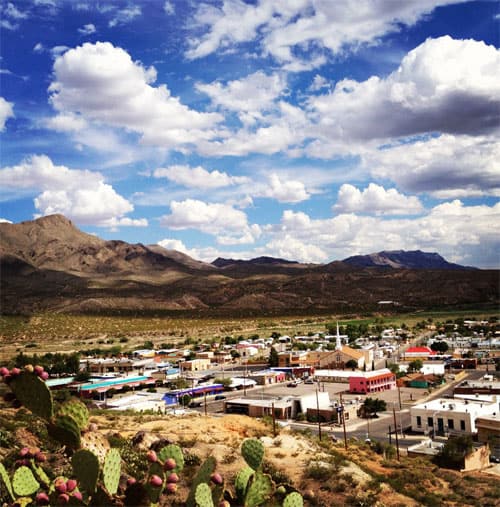The engineer who put together a plan to address flooding and storm water runoff in downtown Truth or Consequences gave a presentation at the Oct. 11 city commission meeting.
That was the only “public meeting” that will be held on the master drainage plan, according to an engineering schedule at the back of a 10 page hand out given at the meeting.
It’s rare when the city has an engineer give a presentation on a plan. But WH Pacific took out ads in the Sentinel stating it wanted public input on the plan, yet the public could not prepare. The plan was not included in the public packet that comes out the Friday before Wednesday morning meetings.
About 10 paper copies of the engineer’s slide presentation were available at the meeting.
The plan is not on the city’s website and the engineer who authored the plan and gave the presentation,
Tom Craig, with NV5 Company of Albuquerque, did not respond to a request for a copy of the plan in time for this article. Craig said he will accept comments until Oct. 25. His number is (505) 348-5212 and his email is craig.tom@nv5.com.
Craig did not explain how or who defined the scope of work for the plan, but said he was to look at the “West Arroyo” and “East Arroyo” that drain into the downtown as well as downtown streets and to evaluate existing drainage patterns. He was to put into priority projects to reduce flooding.
Craig’s model was based on a 100-year flood event. He said the two arroyos had little effect on reducing or contributing to flooding.
His various project suggestions for reducing flooding add up to $8.7 million:
Post St., $1.9 million to “invert” the crown of the road
Clancy St., $800,000 to construct a “6-Ft. valley gutter” in the middle of the road
Daniels St., $800,000 to construct the same “6-Ft. valley gutter” in the middle of the road
Foch St., $2.6 million to “invert” the crown of the road
Pershing St., $1.5 million to invert the crown of the road
Mims St., $1.1 million to invert the crown of the road
Two culverts under S. Broadway St. near the Austin St. intersection, $0, to be cleaned out by New Mexico Department of Transportation
I found it disconcerting that the hot springs hydrology was not considered. This is probably the city’s fault, since the city defined the scope of work. I was also surprised that only traditional and perhaps obsolete hard-scape solutions were offered to drainage problems. Swales, rain gardens and other green infrastructure is much cheaper, more effective in preventing flooding and in keeping our city green and healthy. We are in the desert, but water conservation and use of storm water isn’t considered in the plan.
The city evidently hired WH Pacific to do the plan and that company evidently hired NV5 Company, but I’m not sure and city staff gave no background as to how or when this project was initiated.
I sent Craig both questions and comments on Monday, Oct. 16. If and when he responds, I will do a follow-up article. Please find my questions and comments below:
Could you please send me a digital copy of the presentation you gave during the Oct. 11 city commission meeting? I would like to attach it to an article so that readers may study it and possibly respond by Oct. 25 to the plan.
Could you please send a photo of labeled “Downtown Section” of slide 4? I will use it to illustrate the article.
I am still not clear on how your firm was hired and when and by whom. Can you please tell me? How much is WH Pacific/NV5 being paid?
Can you tell me who at the city determined the scope of work?
I am still not clear on where we are in the engineering-study pipeline. Is what you presented a preliminary engineering study?
Can you tell me why the Wyona development was not included in your plan? It has been in the works about three years now. Since the developer, Nate Stephens of AGNS Construction, asked that it be included in the plan, will you do that? I am not sure if his bridge/culvert/metal pipe was approved by the U. S. Army Corps of Engineers, which supposedly put in the West Arroyo.
I heard the U.S. Army Corps of Engineers put in the arroyo to receive the tailings runoff from a mine that was located behind what is now Tractor Supply on South Broadway/ Business Loop 25.
Did you consult with the Army Corps of Engineers about the West Arroyo? What is their authority or responsibility as far as the West Arroyo is concerned?
There was some kind of water/storm water runoff study done that was mentioned during the Oct. 11 meeting. It had swales and rain gardens and other “green” infrastructure, so I understand, in the plan. Did you get a copy of it? If so, would you forward me a copy?
Are you aware of the hot springs issue in T or C? The Hot Springs District takes up most of the area of your plan. The city, decades ago, perhaps around 1917 or so, when I believe the city was incorporated, dumped tons and tons of fill on top of what was the hot springs’ seep. The hot springs mineral water has over 2500 parts particulate, I think, which makes it a pollutant as far as the EPA is concerned. Filling in the seep, putting in concrete drainage in three locations to collect hot springs runoff from commercial hot springs establishments and hardening the banks of the Rio Grande mostly did away with the filtering and cleansing properties of the seep and quickened polluting runoff into the Rio Grande. It also greatly damaged the artesian pressure of the hot springs.
Does your plan consider the high water table caused by the hot springs?
Is there any way you could restore some of the seepage area to slow down and cleanse storm water runoff? For example, why not return the T or C Rotary Park to a seep? It still has a small cattail section that has survived. The city put in a parking lot next to the river at Ralph Edwards Park, but that could be ripped out and softened. How about permeable pavers in all of the hot springs district?
On slide 29 you talk about placing curb inlets, extending the storm drain under Foch St., but I think that is part of the hot springs drainage put in many years ago. Since it was put in prior to the Clean Water Act of 1972 it is grandfathered in, but I don’t think you can extend it and add storm water to that drain. Please let me know if you find anything definitive about this and the other concrete drains.


if i’m reading this right, it looks like Clancy is being designated to serve as a river as well as a road? with adjoining (road) tributaries?
Is this because the existing arroyos are being marked for development?